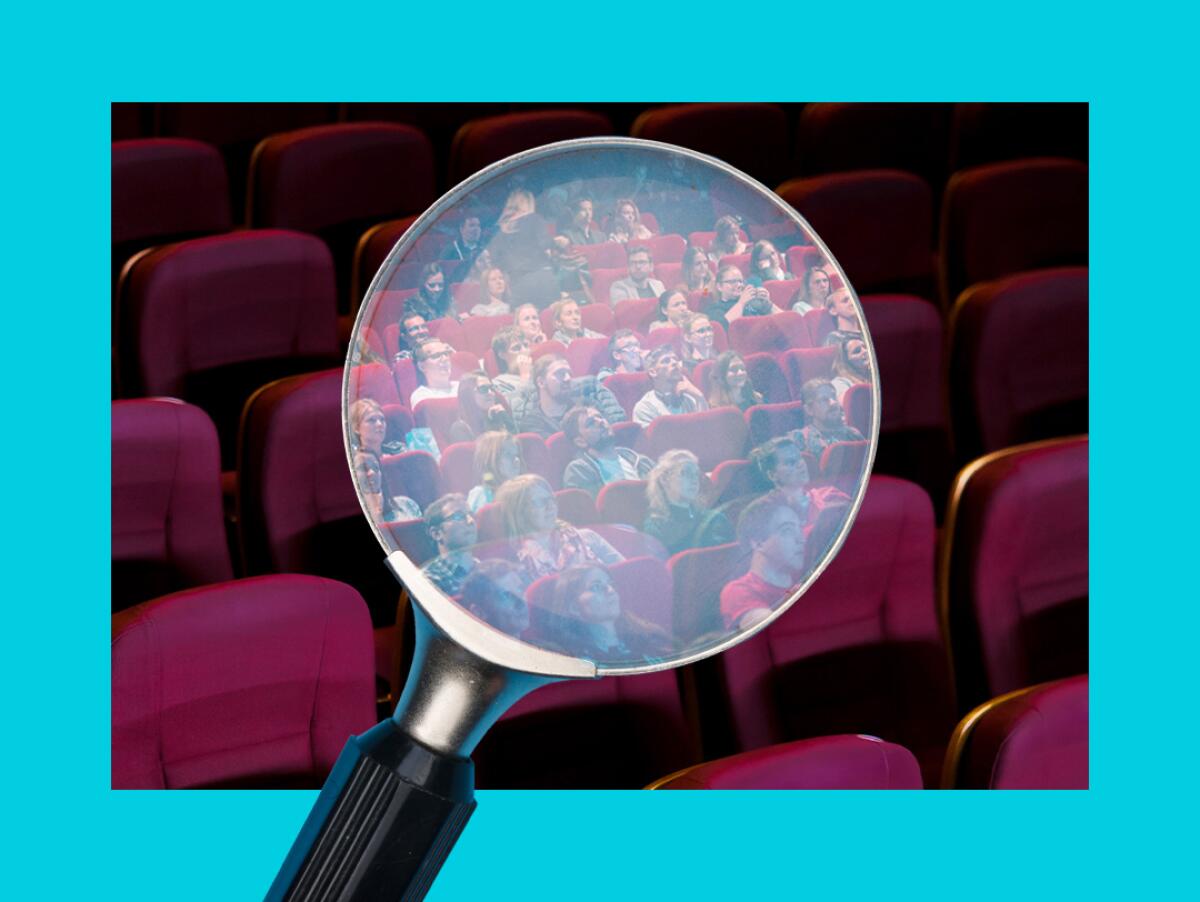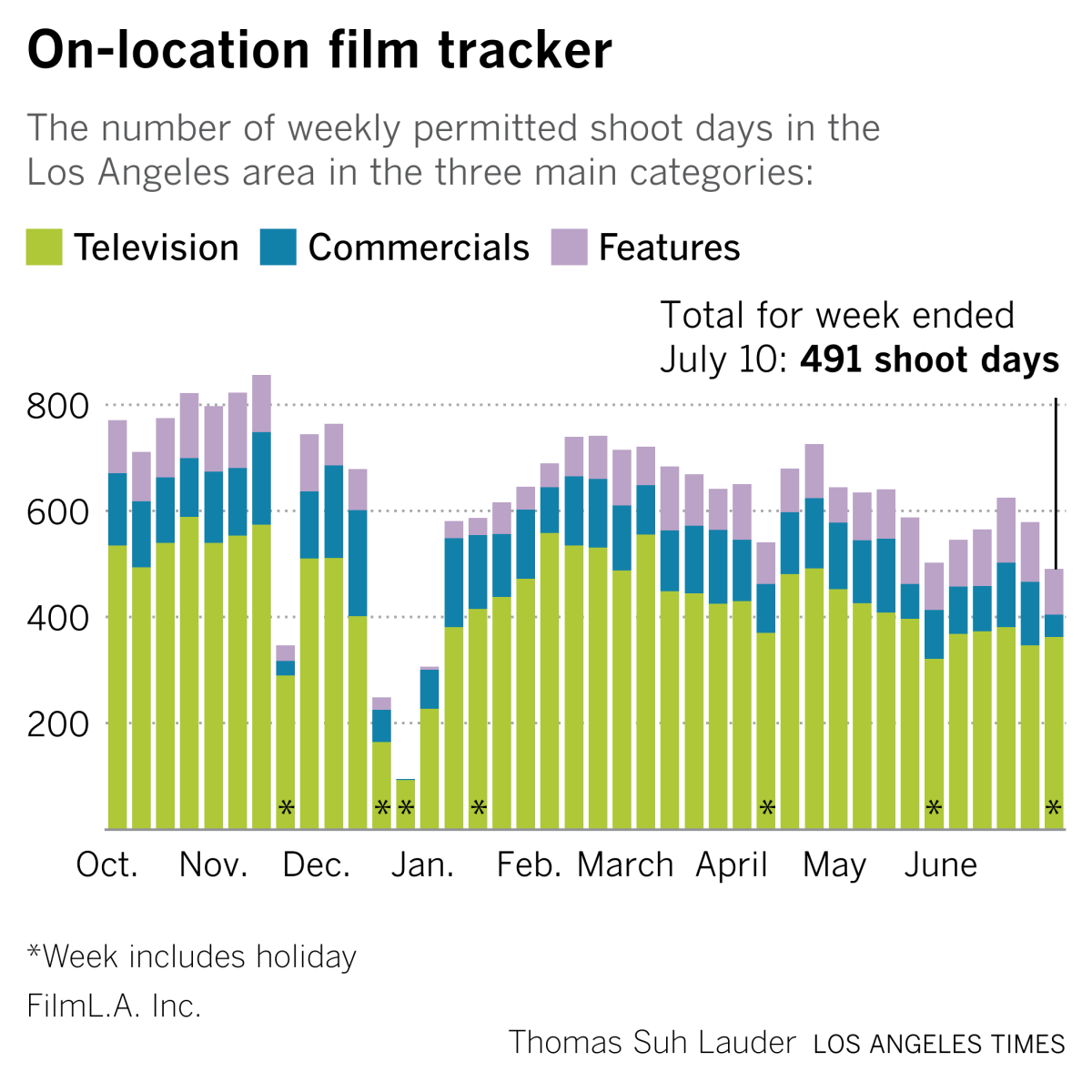Busting the myths of the box office after ‘Top Gun,’ ‘Thor’ and #Gentleminions

Welcome to the Wide Shot, the newsletter about the business of entertainment. Sign up here. It’s free, so not even Elon Musk can get buyer’s remorse.
Let’s get one thing out of the way: The box office is not back. At least not fully.
A number of hits — “Thor: Love and Thunder,” “Top Gun: Maverick” and “Minions: The Rise of Gru” — have shown that certain movies can achieve pre-pandemic-level ticket sales, and even beyond. Their success had exhibitors and distributors rushing to declare the doubters and naysayers wrong, dead wrong.
But most analysts think it could still take years for the theatrical movie business to match the annual grosses the industry hit before COVID-19, if it ever does.
B. Riley’s Eric Wold, among the more bullish Wall Street analysts covering theatrical exhibition, recently reduced his full-year estimates. He now expects total revenue for this year to end 28% lower than 2019, compared to his earlier projection of a 20% decline. Wold cited a handful of disappointments (“Lightyear,” “Fantastic Beasts: The Secrets of Dumbledore”) and a potentially weak third quarter. The rest of the summer, for example, is looking thin, though “Nope” and “Bullet Train” look promising.
So, yes, the business is back, but also not quite back and forever changed.
Right now, there simply aren’t enough midrange, non-blockbuster movies to make up the difference between today’s grosses and the $11.4 billion and $11.9 billion years of 2019 and 2018, respectively. Those types of films, termed “programmers,” don’t get the big July 4 headlines, but they make a major difference for the overall business.
Social media has turned everyone into a box office pundit. But I wanted to bring in some experts and stakeholders to address some of the narratives that emerged or accelerated during the dark days of the pandemic.
And if anything below sticks in your craw, email me here and we may publish your comments.
Theory: The big screen will be back to normal in a couple of years.
Reality: Too soon to tell.
Chris Aronson, president of domestic distribution, Paramount Pictures: “Depends on what one’s definition of normal is. Is the business going to be back to the record-breaking domestic grosses of 2018 in a couple of years? That’s a huge challenge for a myriad of reasons.
“There likely won’t be enough product due to content shifting to streaming services as well as continued consolidation. Also, as long as the big chains are hobbled by debt, they will be unable to put on a quality show in every one of their theaters, which makes the price-value ratio challenging. Also, until exhibition faces the fact that price is a deterrent to moviegoing and gets more creative with pricing schemes, we will likely see attendance continue to fall with fewer people going to the movies less frequently as consumers will seek only high-quality films and shun anything less.
“While there may be challenges ahead, the theatrical business has proved time and time again how resilient and adaptive it can be and I am optimistic that the industry will rise to the challenge yet again.”
Jeff Bock, senior analyst, Exhibitor Relations: “No, the box office isn’t back to its full power yet, but blockbusters are sizzling this summer. I think many have felt this, but there is distinctly less content on screens in 2022, mostly because of production snafus caused by COVID over the last couple of years. So, while we’re seeing big-time box office debuts and even lengthy runs, a part of the reason why is because there are 30% less films in theaters right now. In other words: The box office is extremely top-heavy. Will that change? Yes. Production is back in full swing, and we’ll see the fruits of Hollywood’s labors next summer, when the assembly line gets back up to speed.”

Theory: Family audiences aren’t coming back to theaters.
Reality: Pundits worried that Pixar movies like “Turning Red,” which went straight to Disney+, would train parents and kids to watch new releases at home. After “Sonic the Hedgehog 2” and “Minions: The Rise of Gru,” experts beg to differ.
Jim Orr, president of domestic theatrical distribution, Universal Pictures: “During the pandemic, we heard a lot of speculation that family audiences wouldn’t return to theaters, that they now prefer to stream films at home. We never believed that. The key is, and always has been, to make must-see, high-quality films that everyone, including families, want to experience together in a theater. The record-breaking global opening of Illumination’s ‘Minions: The Rise of Gru’ spectacularly proves that. Audiences have shown us that seeing a great film in a theater with your family and friends is an unforgettable shared experience that just can’t be duplicated on your couch. That’s something that everyone can cheer.”
Rolando Rodriguez, chief executive, Marcus Theatres: “For a lot of reasons, including the pandemic, there simply have not been enough family titles. That is changing. ‘Lightyear’ may not have attained the audience numbers that were hoped for, but a lot of families came to see it. My own family and I personally loved the movie. We have a lot more family-targeted movies coming, but let me tell you, in a Hispanic household, every movie is a family movie. If you’re going to the movies, everybody in the family is going to the movies. That’s how we roll.”
Theory: Older audiences aren’t coming back.
Reality: “Top Gun.” “Dog.” “The Lost City.”
Rodriguez: “Audiences of all ages are coming back. We see it in the demographic breakdowns of every movie we show. I see it when I go into our movie theaters. The same percentage of audiences over 45 went to ‘Spider-Man: No Way Home’ as went to ‘Avengers: Endgame’ — that’s a lot of older moviegoers. They turned out for ‘The Lost City’ and ‘Dog’ and ‘Everything Everywhere All at Once’ and audiences over 35 made up 55% of the opening weekend for ‘Top Gun: Maverick.’ What we don’t have are enough movies specifically targeting that age group, but they will come.”
Amy Baer, president, Landline Pictures: “They never went anywhere. Distributors tend to ignore this slower-moving cohort, and so this group often ignores the content that is available. As a result, everyone hand wrings and bemoans the evaporation of the older audience. But, if you make it, they will come. Go back three decades (‘Grumpy Old Men’ to ‘Book Club’) and see a regular pattern of movies about/for older audiences that are consistently — and ‘shockingly’ — hits. Full disclosure: I currently run a label for MRC Film, Landline Pictures, that focuses on this audience segment (our first film, ‘Jerry & Marge Go Large,’ is now streaming on Paramount +); but I’ve worked on ‘older-skewing’ movies (‘Something’s Gotta Give,’ ‘Last Vegas’) my entire career and all have succeeded because they reflect an older audience’s life experience. Make something that feels RELEVANT and RELATABLE to an older audience, and they will consistently support the movie — in theaters or streaming. They have the resources of time and money and an ingrained moviegoing habit; they just need movies that appeal to them!”

Theory: Young people prefer TikTok and video games to movies.
Reality: Young people are increasingly gravitating toward video games and user-generated social media content as their preferred sources of entertainment. But teens are literally dressing up in formal wear to watch “Minions” because of TikTok.
Shawn Robbins, chief analyst, Boxoffice Pro: “Even since before the pandemic, the industry’s harshest critics have prophesied the death of cinema and that families won’t come back. Before that, there were concerns that the broader moviegoing audience was aging out and that today’s youth are more interested in TikTok and YouTube videos for entertainment than going to the movies. On the contrary, the #Gentleminions trend showcases what kind of positive impact social media can have on a film.
“Those doomsday narratives have effectively been laid to rest. Young audiences drove the early stages of moviegoing’s rebound in 2021 and continue to turn out in large numbers, ‘Top Gun: Maverick’ has cemented its place in history as the film that brought back a big portion of the adult audience, and films like ‘Minions: The Rise of Gru’ and ‘Sonic the Hedgehog 2’ have rallied families who were ready for that communal, out-of-home theatrical experience again.”
Bryan Smiley, president and chief content officer, Hartbeat: “The glory days of movies aren’t behind us. Over the last several years people have prophesied the death of the movie business. The conversation driving this ongoing myth often focuses on the shortened attention span of modern consumers and competition from other forms of media. Our business, like so many others, is in a state of disruption driven by changing consumption habits and new technologies. However, one thing that has never changed is the desire for great storytelling. Sure, distribution models will evolve and monetization strategies will be perfected, but movies as art and commerce will continue to not only survive, they’ll flourish.”
Theory: Streaming is replacing theatrical filmgoing.
Reality: The amount of quality content on Netflix and other streamers has raised the bar for theatrical movies. But there’s evidence that streaming and theatrical is not a zero-sum game.
Megan Colligan, president, Imax Entertainment: “Where do I start?! The domestic box office is showing that even the most mature market can grow. Streaming isn’t replacing theatrical; it competes against cable television, always has. People are rediscovering that movies are among the most affordable ways to travel, escape, and make memories.”
Abhijay Prakash, president, Blumhouse: “There is an oversimplification to the way theatrical recovery and streaming are currently being categorized. The strong performances of ‘Top Gun,’ ‘Jurassic World’ and ‘Minions’ have heralded definitive proclamations of theatrical being ‘back’ with all the spoils exclusively accruing to big franchise titles while streaming’s stock market stumbles suggest some kind of demise. These hot takes miss the more complex economic reality — critical for sustaining our business — that a diverse set of films are drawing a range of audiences to theaters and that streaming is working in service of — not in opposition to — theatrical releases.
“Beyond these mega-tentpole successes there are also successful original theatrical titles including ‘The Black Phone’ plus other recent titles also earning $100 million worldwide including ‘Everything Everywhere All at Once,’ ‘Elvis’ and ‘Lost City.’ These titles plus other non-tentpole earners like ‘Scream,’ ‘Jackass’ and ‘Downton Abbey 2’ form a critical part of the marketplace recovery by bringing a wide array of audiences — young, old, arty and diverse — into theaters.
“Second, most of these titles are also delivering profitable returns through a business model that manages film costs and captures the residual heat from the theatrical marketing and strong word-of-mouth and converts it into revenue via accelerated downstream windows like PVOD and streaming subscriptions. Though it may not be publicly reported, the underlying economic reality of the business model for these films is that streaming can help sustain theatrical.”
Shelli Taylor, CEO Alamo Drafthouse Cinema: “I laugh at every theatrical doomsday headline that the industry is dead and streaming is king. Just look at the amazing 2022 movie slate, and then try to see a movie without a pre-purchased ticket in hand. You can’t. While the world rapidly evolves and changes, increasing human isolation and separation, there are few things left that open our hearts and minds bringing humanity together. … Theater does that.”

Theory: “Woke” politics are hurting business.
Reality: There’s anecdotal evidence (i.e., scrolling Twitter) that some parents were uncomfortable with the notion of the gay kiss in “Lightyear,” and that this dampened box office returns. But there’s little hard data yet to suggest a major backlash against “wokeness” affecting sales industrywide. In fact, inclusivity, in terms of people of color and women, tends to improve business.
Kendall Phillips, professor and pop culture expert, Syracuse University: The whole ‘wokeness is hurting box office’ claim seems very bizarre to me. It just doesn’t seem to track onto the actual numbers. If you take Marvel as the gold standard of big contemporary box office, one of their first major inclusive films was ‘Black Panther,’ which grossed over $1.3 billion. Same for ‘Captain Marvel,’ which was heavily criticized as too woke but ended up over $1.2 billion. The reality seems to be that big franchises like the MCU are trying to expand to include a more diverse set of characters and that the majority of global audiences are showing up for it.”
Theory: Movie theaters are only for “event films.”
Reality: “Everything Everywhere All at Once” has made $67 million domestically.
Greg Silverman, founder and CEO, Stampede Ventures: “The idea that movie theaters are for ‘event films’ only is absurd. Theatrical distribution will continue to be the place where franchises are born and where they are monetized. The movie going experience is twofold — a place where audiences can go to see something nostalgic and well executed, as well as a place to be surprised by something fresh that inspires people to become advocates for new projects. These are the joys of the in-theater experience. Ten years ago. Today. And 10 years from now. ‘Top Gun’ is a win, but so is ‘Everything Everywhere All at Once.’”
Theory: The future of midbudget and indie film is on streaming.
Reality: Though movies like 20th Century’s “The Princess” (Hulu) are going straight to streaming, many midrange titles are not, like Warner Bros.’ “Don’t Worry Darling.” Studios are still learning what strategies work best for which films.
John Fithian, president and CEO, National Assn. of Theatre Owners: “The creative community and many high-level studio executives would strongly disagree with this. Midrange movies stand out more and are viewed as more valuable to the consumer when they are given a proper theatrical release. Plus, they make actual dollars in theatrical that you can actually count. This fall theatrical slate is full of really solid midrange titles that will bring people back and prove that they are just as full of potential as they’ve always been.”
Theory: Superhero dominance sucks oxygen out of the rest of the business.
Reality: Three of the top 10 films this year are superhero pictures. But other stuff is working too.
Phillips: “While superhero films continue to draw big box office, I don’t think it is fair to say audiences only want capes and costumes. Looking at the box office so far in 2022, it seems to me that the story is not ‘it is all superheroes’ but that it is all big-emotion films. I think the real lesson, at least at this point, is that audiences are willing to head to the theater for big emotional payoffs — either thrills or chills. While streaming is nice for intimate viewing, the theater is still the best place to experience that kind of big rush of emotion.”
Paul Dergarabedian, senior media analyst, Comscore: “Those who say everything is superheroes just aren’t looking closely enough or are using that idea as a way to insinuate that independent film is dead or that audiences only want to see caped style crusaders on the big screen which is patently untrue. Just ask Michelle Yeoh, ‘Marcel the Shell,’ ‘Elvis,’ ‘Mr. Malcolm’s List,’ Tom Cruise or even Nicolas Cage for that matter. It’s not just about the younger audience and superheroes, but a wide variety of audiences being attracted to a very diverse slate of films big and small.”
Stuff we wrote
— Why former Fox boss Peter Chernin has stayed independent: ‘Sanity.’ The ‘Ford v. Ferrari’ producer has secured $800 million in equity and debt financing to take his new company, the North Road Co., to the next level.
— Blizzard’s new boss wants to have fun with games. But first, his company is in a crisis.
— E3 will make its L.A. Convention Center comeback in 2023 with an online component too. The annual event will return to the Los Angeles Convention Center three years after forgoing in-person gatherings due to the COVID-19 pandemic.
— Podcast: The rise and fall of a Hollywood almost-was. Meg James and Amy Kaufman discuss their big investigative story on Randall Emmett.
— Headlines, headlines, headlines. Amber Heard faces new legal battle, this time with her insurer over Depp suit. In the ’90s, a new breed of rock stars organized for abortion rights. Could that happen today? Lea Michele is Broadway’s next ‘Funny Girl.’ So Beanie Feldstein is leaving early. Florence Pugh doesn’t care what anyone thinks about her breasts: ‘Grow up’
Hollywood production
Shoot days in the Los Angeles area were down last week due to observance of the July 4 holiday, according to data from FilmLA.

Catch-up reading...
— Hell yeah, Tom Cruise. On the enduring, complicated appeal of the “Top Gun” franchise. One of the most entertaining pieces of film criticism you’ll read. (The Atlantic)
— Hell no, censorship. Hollywood isn’t budging for China’s censors anymore. (CNN)
— Billionaire summer camp. On the absurdity of trying to cover the annual media mogul confab in Sun Valley. (New York)
— In a pickle. On the existential crisis Disney and Comcast are facing over Hulu. (CNBC)
— ‘Debra Messing was fed up.’ Progressives are angry with the White House after the demise of Roe v. Wade. (CNN)
Finally ...
I was completely transfixed by “Navalny,” the HBO Max/CNN Films documentary about the Russian opposition candidate who survived a poisoning attack and returned to his home country only to be detained. The movie is worth watching, especially for a scene that I would only describe as “Assassin ‘Crank Yankers.’” Here’s Justin Chang’s review.
Inside the business of entertainment
The Wide Shot brings you news, analysis and insights on everything from streaming wars to production — and what it all means for the future.
You may occasionally receive promotional content from the Los Angeles Times.




